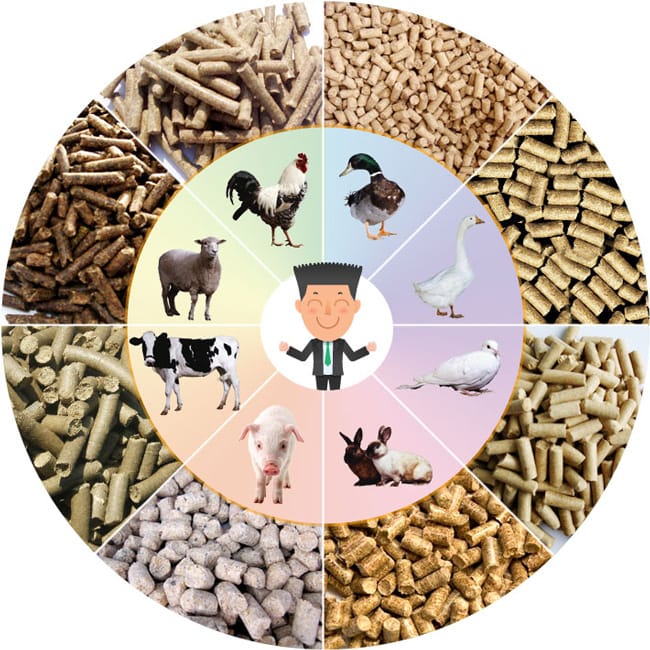Application of seaweed in livestock and poultry feed
Seaweed is a kind of self-proliferating organisms that is extremely widely distributed in the ocean. Through photosynthesis, it converts inorganic substances in the ocean into organic substances. At present, there are about 1,000 species of seaweed plants discovered, which can be divided into more than 10 categories such as Chlorophyta, Phaeophyta and Cyanophyta. These algae are rich in seaweed protein, polysaccharides, fats, vitamins, minerals and physiologically active substances with special functions. They are a treasure trove of natural raw materials for food, feed and medicine. At present, the world's annual production of seaweed powder reaches 150,000 tons, and the development and utilization of marine resources to develop food-saving animal husbandry is promising and promising.

1. The nutritional value of seaweed
The nutritional value of seaweed is very high. According to the measurement, the crude protein contained in seaweed is 8%~12%, up to 17%, and the nitrogen-free organic compound is 30%~60%, mainly seaweed gum, starch, mannitol, cellulose, etc.; it also contains a variety of Minerals account for about 20% to 30%, mainly containing potassium, sodium, calcium, magnesium, strontium, iodine, cobalt, phosphorus, manganese, zinc, selenium, etc. The iodine content is 0.4% to 0.7%, which is a natural supplement Iodine is the best feed additive, and it also contains VA, VC, VE, VB1, VB2, VB12 and other vitamins. It also contains pigments and many active substances that can promote animal growth.
Among them, the total amount of amino acids in the three seaweeds of Ulva, Yitai, and Enteromorpha is 9.6%, 8.6% and 5.9%, respectively. The latter two seaweeds are higher than those of corn, rice and sorghum. The essential amino acid content of the above three kinds of seaweeds are 4.5%, 4.1%, and 3.0%, which account for about 47%-50% of the total amino acid; and the lysine content is 0.4%, 0.44%, and 0.36%, respectively. The content of lysine in rice and sorghum are 0. 25%, 0.30% and 0.24% are not as high as the content of the three kinds of seaweed feed. Therefore, seaweed is a new high-quality feed additive for livestock and poultry.
Before we introduced many applications of seaweed in aquaculture, today we will mainly look at the application of seaweed in livestock and poultry.
2. Application effect of seaweed in livestock and poultry breeding industry
Currently, large seaweed is fed directly or processed into seaweed powder as feed. Coastal areas are rich in seaweed resources and can be produced and processed into seaweed powder on their own, while inland areas can directly purchase and feed the processed seaweed powder.
(1) Application of seaweed in chicken feed
Adding 3% seaweed powder to layer feed to replace the same proportion of wheat bran, etc., can improve the feed conversion rate and save the amount of concentrate, increase the egg production rate by 7%, and reduce the egg broken rate by about 5%, and Can significantly reduce the cost of feeding.
Due to the high iodine content of seaweed powder, adding 5% seaweed powder to the diet of laying hens and feeding for 7-15 days can produce high-iodine eggs, which can significantly increase the economic benefits of raising chickens.
Adding 2% seaweed powder to the broiler chicken diet can increase the growth rate by 15%-20%, increase the feed conversion rate by 12.5%-15%, and significantly reduce the mortality rate.
In addition, according to some current research reports, seaweed polysaccharides in seaweed can promote the performance of livestock and poultry, intestinal health, immunity and other aspects in animal husbandry production.
(2) Application of seaweed to other livestock and poultry
According to experiments, the addition of 5% seaweed powder to the dairy cow's diet can promote feed intake, increase milk production by 5%, increase milk iodine content, and increase the nutritional value of milk, diseases of reproductive organs and breast diseases of dairy cows. Significantly reduced, the conception rate of breeding increased.
Adding 4% seaweed powder to lactating sow feed can increase milk production by more than 8%, piglet growth is significantly accelerated, weaning weight is increased, disease is significantly reduced, and survival rate is greatly improved; in the diet for growing and finishing pigs Adding 2% to 3% seaweed powder can increase daily weight gain by 18%, save feed by 2% to 4%, and achieve a feed-to-meat ratio of 3.2:1 to 3.1:1, which can reduce morbidity and make pigs healthy.
Adding 35g of seaweed powder to each sheep's diet every day can increase wool production by 20%, greatly improve the survival rate of sheep, and prevent the occurrence of sheep alopecia and white muscle disease.
In short, when seaweed powder is used as a feed additive, it can not only effectively improve the nutritional structure of feed, but also increase the utilization rate of feed. At the same time, it can improve the quality of livestock and poultry products, and improve the ability of animals to resist diseases and stress. Animal production performance and breeding benefits.
If you want to built one complete pellet production line in your country, pls send the inquiry to us. We will customized design according to your requirement.



